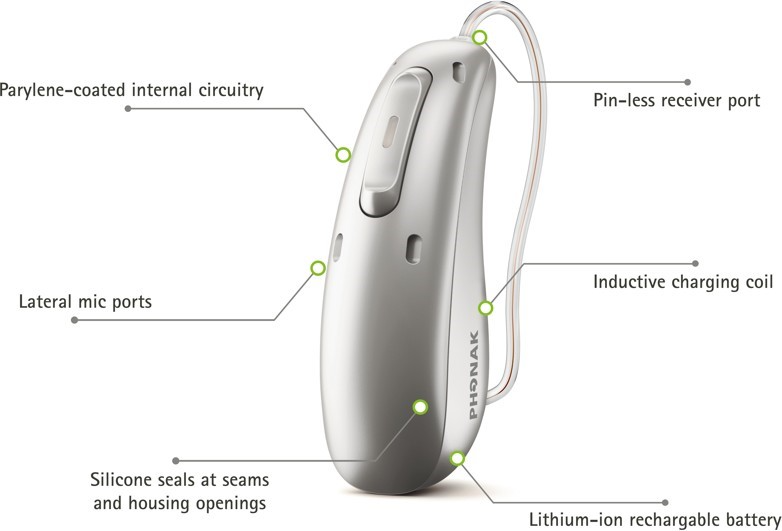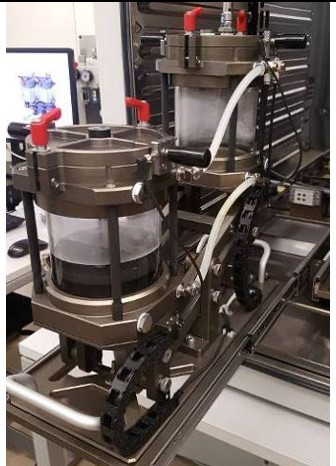Question
How does Phonak Audéo Life™ set a new standard for reducing patients’ anxiety around water and physical activities?
Answer
The importance of waterproof hearing aids
For decades, water has been one of the biggest enemies of hearing aids. Research shows people with hearing loss experience anxiety wearing hearing aids around water. Introducing Audéo Life, the world’s first waterproof* rechargeable hearing aid, with additional protection against moisture, sweat and other challenging real-world conditions.
In a recent survey of people with hearing loss in the United States, Germany, and Australia, up to 68% of participants reported they would feel anxious wearing hearing aids during water- based activities like going to the beach, working out, or swimming.
Testing hearing aids for waterproofing
Many hearing aids, including those from Phonak, are specifically marketed as being “water resistant.” While there is no industry standard for what water resistant and waterproof actually mean in terms of real world performance, hearing aids are assigned an Ingress Protection code or IP rating to demonstrate the level of protection hearing aids have against moisture and debris intrusion.
The first digit indicates protection against dust and debris intrusion, and can range in value from 0 (no protection) to 6 (full protection from dust). The second digit indicates protection from water intrusion and can range from 0 (no protection) to 9 (can withstand direct spray of high- pressure, high-temperature industrial water jets from multiple angles). Most hearing aids sold today carry an IP68 rating, indicating full protection from dust and debris as well as survival in a given depth of water for a specified number of minutes as defined by the manufacturer. For Phonak hearing aids, that is one meter (3.28 feet) of freshwater for 60 minutes with the hearing aid still functional once removed from the water.
What makes Audéo Life different?
Audéo Life was specifically designed to combine the proven hearing performance and crisp natural sound2 of Audéo Paradise with a housing that is built to withstand the harsh environments that hearing aid wearers may find themselves in on a regular basis. This includes humidity, sweat from heat and physical activity, and sea and pool water. But how is this different from a normal hearing aid?
Audéo Life has several key features that provide enhanced protection from moisture intrusion. These include:
- Additional protection over the rear microphone to protect from direct water pressure.
- Inductive charging that eliminates the need for titanium posts in the hearing aid, reducing the number of openings in the housing.
- Coating of the internal module and rechargeable battery with a thin layer of parylene (a flexible plastic polymer often used to protect sensitive electronic equipment from damage due to moisture and corrosion in inhospitable environments).
- Silicone seals added behind the receiver port, locking pins and housing seams.
- A pin-less receiver port that not only further reduces the number of open points in the housing, but also no longer requires a tool to change the receiver.

Immersion testing: Audéo Life goes beyond IP68
Designing a robust hearing aid was only the start. A battery of additional tests beyond IP68 was designed to prove that Audéo Life could withstand harsher conditions. Depth tests in seawater and pool water were conducted using Audéo Life hearing aids.
Audéo Life hearing aids were placed in two climate-controlled chambers, one filled with seawater to simulate diving into the ocean and another filled with chlorinated water to simulate being submerged in a pool. Both test chambers were pressurized to 50 mbar to simulate a depth of 50 centimeters of water and heated to a temperature of 50°C/122°F to accelerate the conventional aging process of the hearing aids and simulate their 5 year intended lifespan.3


Figure 1: Test setup of the seawater and pool water dive test in climate-controlled chambers.
Additional acoustical measurements with all hearing aids as well as a radio frequency (RF) link performance tests were conducted. They were performed on the hearing aids before and after the depth tests using the Maximum Power Output (MPO) and Full On Gain (FOG) with a 50dB SPL input signal. The Reference Test Setting (RTS) frequency response was measured with a 60dB SPL input signal.
The results showed that for seawater, seven out of ten hearing aids were still functioning within normal limits after the 520 test cycles. Of the three that did not pass, one hearing aid failed after 147 cycles, one failed after 288 cycles, and the third also failed after 288 cycles. However, the third hearing aid did recover after being allowed to dry and later tested within normal limits. For pool water, nine out of ten hearing aids passed the final test, with one failing after 520 cycles.
Take your patients’ confidence to the next level
Audéo Life takes patients’ confidence to the next level with the first rechargeable hearing aid that is waterproof* and sweatproof. Wearers can now feel confident their hearing aids are protected around water and during physical activities. With the proven hearing performance and advanced features of the Paradise platform, wearers can enjoy the best of Phonak technology with the peace of mind provided by enhanced protection from water.
For more information on Audéo Life, contact your Phonak representative, or click here.
References
- Taphuntsang, D.(2020). Market research ID 4398. Please contact marketinsight@phonak.com if you are interested in further information.
- Taphuntsang, D. (2020). Market research ID 4387. Please contact marketinsight@phonak.com if you are interested in further information.
- Phonak internal testing protocols.
*Up to 50 cm

